My Golspie Backyard Ultra Win: Training, Mindset & Practical Tips
- Kayleigh Webster
- Feb 7
- 10 min read
Updated: Sep 8
There we were, lined up at the start for what would be our 31st lap in as many hours. The whistle blew, but instead of springing forward as I had done every hour before, my friend and fierce competitor Vic reached out and gently pulled me back. Confused, I wanted to urge her to get moving—the clock was ticking! But she calmly told me she wouldn’t be continuing and that I should go on to take the win. Suddenly, the reality of it all sank in. After a big celebratory hug, I was off, heading out on my victory lap at the Golspie Backyard Ultra.
A Beautiful Start
Rewind 33 hours to a peaceful morning scene: I was tucking into a bowl of porridge topped with banana, cinnamon, and sugar while chatting strategies with Michael, my partner and chief crew. We were treated to a glorious sunrise over the sea, all viewed from our camper—pure bliss for what would be a long (very long!) weekend of running.
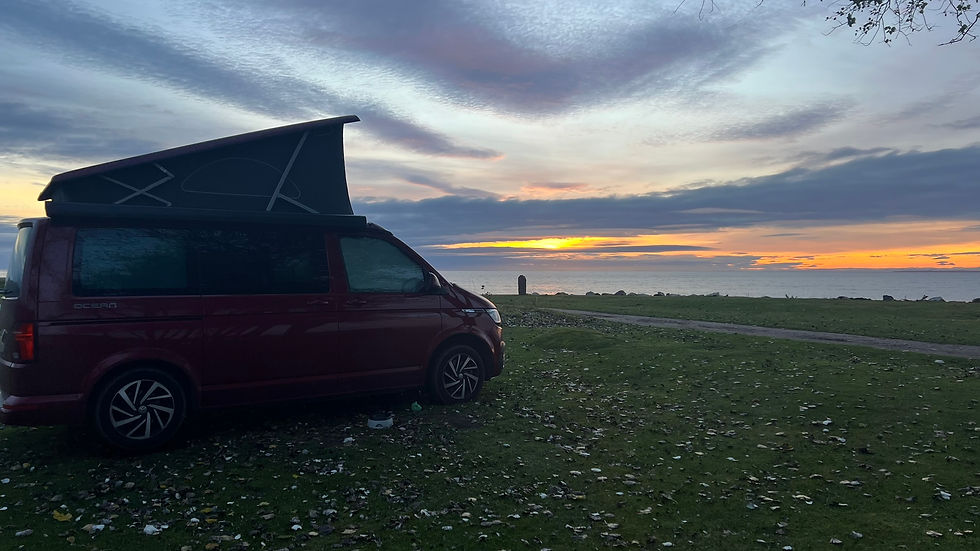
After breakfast, I focused on setting up my shelter close to the start line—just 20 metres from the corral. I laid out bananas, crisps, sandwiches, spare clothing, and multiple head torches, making sure everything was easily accessible. Being November in the north of Scotland, we fully expected a cold snap, so we had blankets and a DryRobe ready to fight off the chill. But in a stroke of good fortune, the weather stayed remarkably mild. The final step was pinning on my race number—28—before heading to the briefing with a big grin on my face, ready for the first whistle.
What is a Backyard Ultra?
A Backyard Ultra is a unique type of ultramarathon with a simple but brutal format: runners must complete a 4.167-mile (6.7km) loop every hour, on the hour. You have 60 minutes to finish each loop and be back in the start corral before the next one begins. If you miss the cut-off or choose not to continue, you’re out. The race only ends when one runner completes a solo loop after everyone else has stopped — hence the title Last One Standing.
There’s no set finish line, no set distance. It’s as much a mental game as a physical one, where strategy, fuelling, pacing, and mindset matter just as much as speed. Every new hour is a new start line — and the potential to go further than you ever thought possible.
Golspie Backard Ultra: The Route
From the starting corral, we followed a narrow path along the seafront (cue much shuffling and bunching together) before reaching a modest hill. No big deal at first, but it was enough of a climb to remind you to pace yourself. After this, the track opened up into a more spacious straight, then dipped down and around the spectacular Dunrobin Castle, giving us fairy-tale vibes.
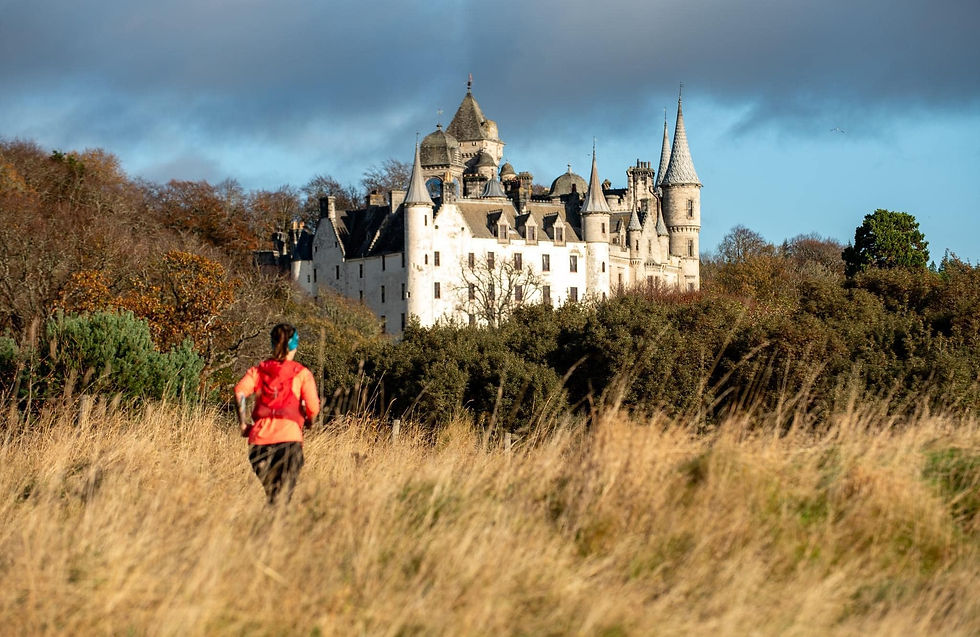
Further along came a gradual incline—tempting to run, but I opted to power walk instead and save energy. The reward? A wonderful downhill through the woods, followed by a woodland rollercoaster of undulating trails. Taking in breath-taking sea views, I reminded myself I’d still be running by the time the sun rose again.
Eventually, the course wound back to the shore, passing spectators before tackling the infamous “sweary hill” (steep enough to burn the quads!). After that, it was a return journey down that first hill and along the seafront back to the start. That was 4.167 miles completed—only countless more loops to go!

Early Laps & Strategy
I aimed for 48–50-minute loops to allow enough time to refuel, change clothes, or just put my feet up. It feels almost silly to rest after every 4-mile loop, but those short breaks early on truly pay off later.
The first few laps are all about finding your rhythm—working out where to run, where to walk, and identifying time markers. This is also a brilliant chance to chat to fellow runners. At Golspie, I discovered many people had run the inaugural event last year, a testament to how special it is. (Fun fact: by the time I’m writing this, the 2025 edition is already sold out!)

It’s All About Preparation
My previous Backyard Ultra at Rasselbock (March) was a learning curve. I struggled to stomach my usual go-to foods once the night set in, and a meagre diet of a single banana and a packet of crisps over 30 miles led to a predictable crash. Despite this, I notched up 19 yards (nearly 80 miles), which was still a distance PB for me.
Eager to improve, I used the West Highland Way Race as a trial ground for fuelling through the night. Adding Tailwind for liquid calories, plus bananas and crisps, saw me push through 97 miles in 27 hours—a huge confidence boost. This made me believe 27 yards at Golspie was definitely within reach.
My Unconventional Training
Rather than following cookie-cutter plans or even a coach’s schedule, I’ve learned to trust what works for me. Two big training highlights stood out:
12-Yard Simulation
I replicated a backyard ultra by running 4.167-mile laps on the hour at my local country park, using my campervan as a makeshift aid station. I pushed the pace a little, consistently hitting 47–48 minutes per loop, leaving valuable rest time.
7 Marathons in 7 Days
Yes, this sounds like lunacy, but it was the perfect way to embed run-walk strategies. I completed this block three weeks before Golspie, giving me time to recover. It was tough but gave me huge confidence leading into race weekend.
You Can’t Plan for Everything
My partner Michael found himself assigned to spider-slaying duty while setting up camp—apparently, the North of Scotland’s spider population decided to show up and say hello! Armed with baby wipes and a steely resolve, he faced them down, ensuring my mini base remained as bug-free as possible.
Embracing the Darkness
Before long, day turned to night—a 14-hour stint of darkness, typical in a Scottish winter. Thankfully, I was prepared and actually looked forward to the peace of running under the stars. My Fenix headtorch was a lifesaver, though I also carried a spare while charging the main one as needed.
I felt surprisingly energised, especially when I finished loops quickly enough for a brief rest. Apparently, I even squeezed in a couple of micro-naps, despite not feeling like I was sleeping. Each time, I’d rejoin the start line with a bit more bounce in my stride. By 5 am, I had passed my previous PB of 19 yards, and that alone felt fantastic—plus, we were closing in on sunrise and the 24-hour/100-mile mark.

Handling the Pain Cave
I’m known for maintaining a positive mindset even in tough spots, but challenges do come. The first real wobble hit after 12 loops (50 miles). I’m not sure why, but I refused to dwell on it. In a backyard ultra, each loop is just an hour, and the short downtime can be all you need to reset. My best advice is: accept the negativity but don’t indulge it, then focus on reaching the next loop for a hot drink, fresh socks, or a short rest.
A second lull arrived around 25 hours, when fatigue really kicked in. I usually run without music or podcasts, but I keep them as a mental booster if needed. Some up-tempo tunes like Metallica or Lizzo helped, but the real game-changer was listening to a voice note I’d recorded just before race day—my confident, well-rested self reminding me how ready I was for this. It instantly flipped my mindset back to belief.

Reaching 100 Miles & Beyond
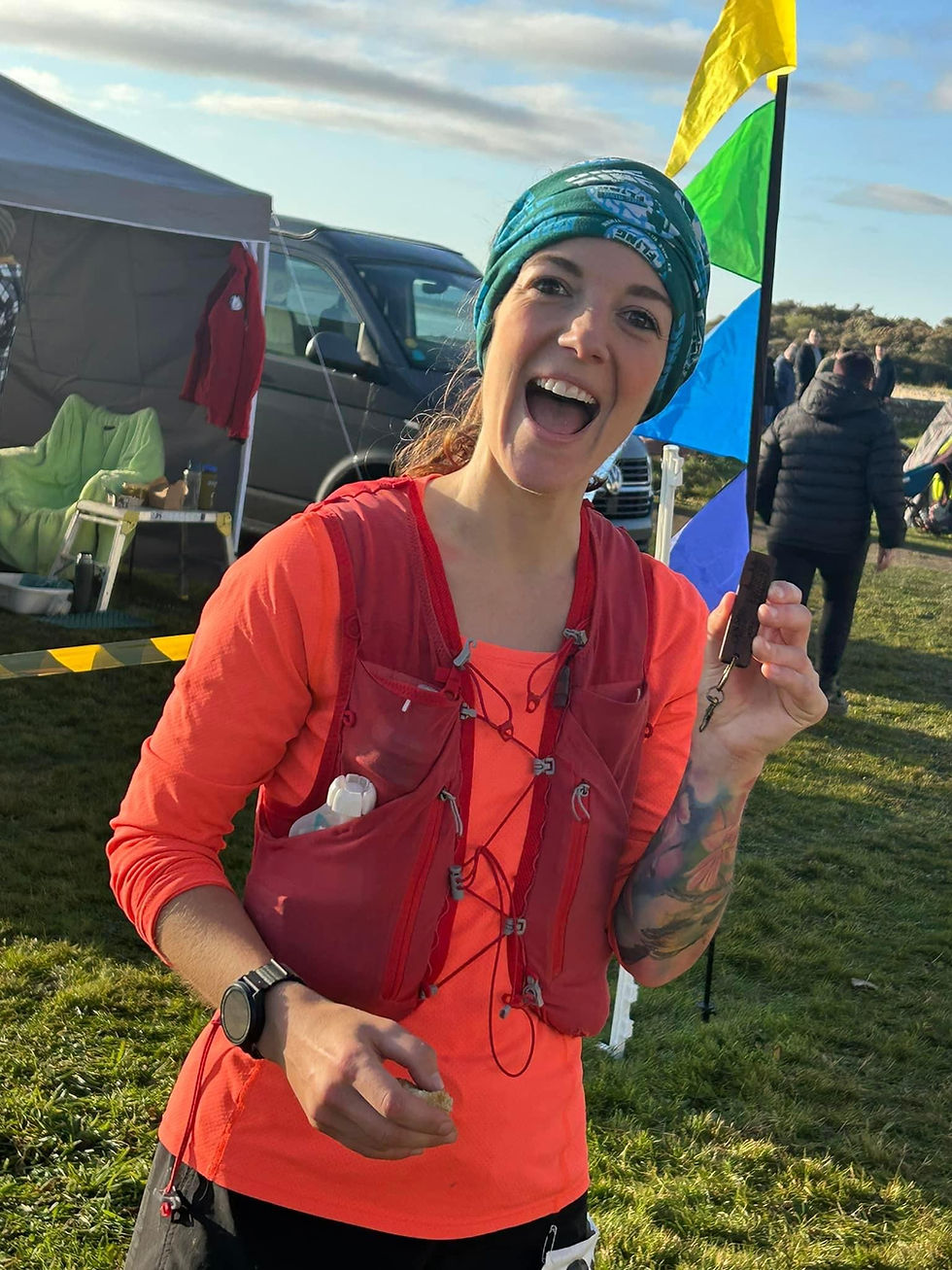
Sunday morning brought the return of runners who had dropped out overnight, cheering on the remaining competitors. The clock struck 24 hours (100 miles), and no one pulled out—a rare feat. By the start of yard 26, we were down to seven runners, and the sun was shining warmly enough that I debated shedding layers. I joked it wouldn’t be long before I’d need them again—mentally reinforcing that I’d still be running at sunset!
Making History
Around this time, Vic noted a UK Backyard Ultra first could happen if we ended with a female assist (second place) and female winner. That potential kept us both going. We also chatted about possibly hitting 30 yards and maybe even bagging a spot in the 4 Nations Championship.

By yard 29, it was just three of us—Martin “The Flash” Gordon, Vic, and me. Martin, who had repeatedly said “this is my last lap,” finally called it a day after 29, leaving Vic and me to achieve that female assist and female winner. We practically buzzed with excitement as we headed out together on yard 30. The support from volunteers, spectators, and dropped-out runners was unreal.

And Then There Was One
We returned for yard 31, and the whistle blew. That’s when Vic made her stunning decision to pull me back and let me go on alone, saying she’d hit her target of 27 yards and wanted me to take the victory. We shared a long hug before I powered off into the final lap, the sun setting in a golden glow over Dunrobin Castle.

Crossing the finish line for the last time, I was absolutely overjoyed. In classic ultra fashion, I immediately dashed to the loo to be sick, but nothing could dampen my mood. I was presented with a hand-crafted clock from The Kraft Shed in Brora, featuring an etching of Dunrobin Castle, and a beautiful slate plaque declaring me the Last One Standing, 31 Yards (129.16 miles).
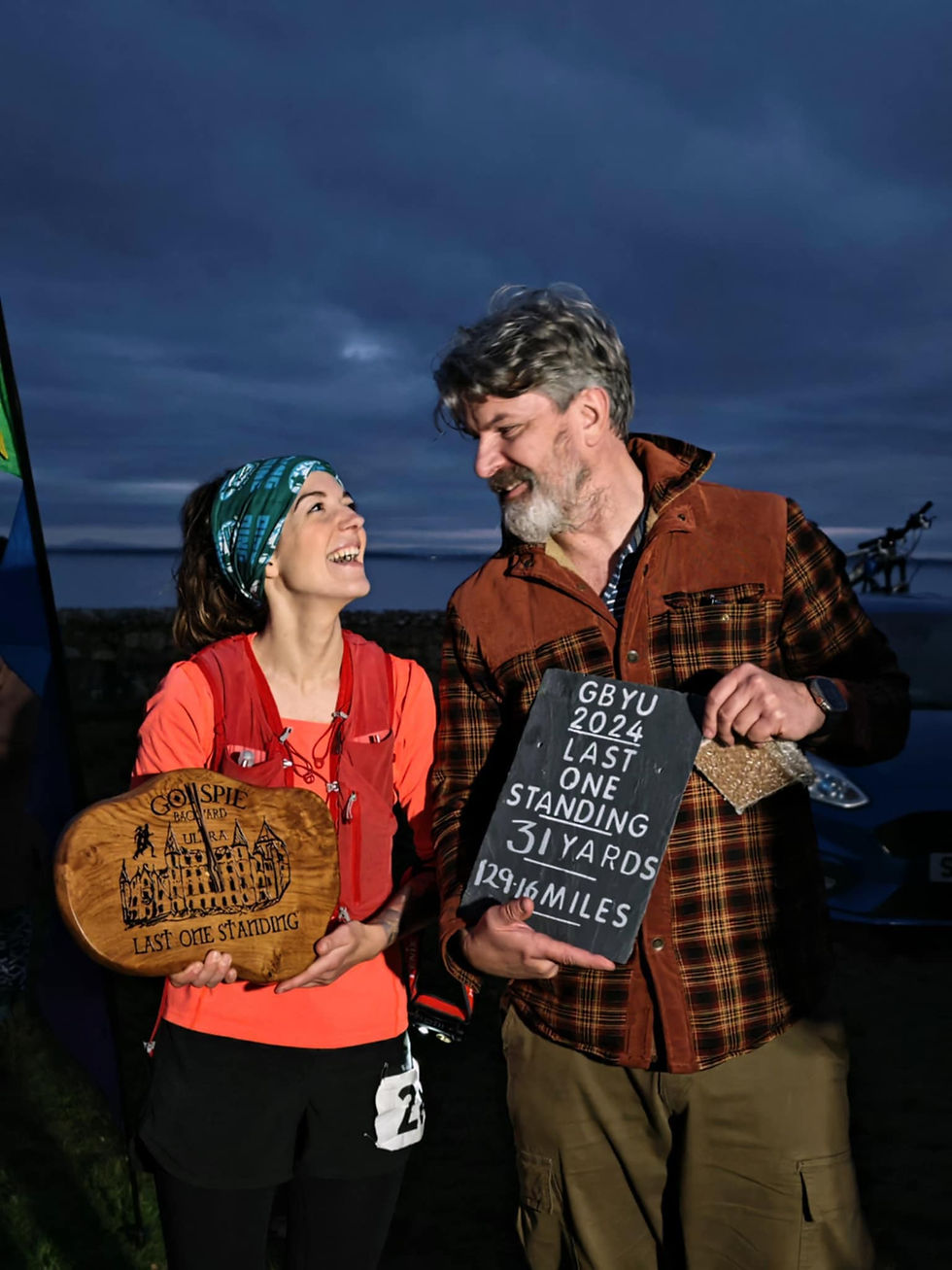
My Race-Day Setup
Since buying a camper van in March, it’s become an ideal base for ultra events. We parked it away from the noise so Michael could get some rest. I had an inflatable shelter near the corral with a table for food, a reclining deck chair, and my DryRobe always on hand. Every lap, I’d sit down, wrap up, and if I wanted a quick sleep, I’d turn off the light while Michael kept watch, waking me at the 3-minute warning.
Taking Care of Your Crew
Michael’s first evening was fairly relaxed—he watched rugby, savoured a few beers, and stayed alert for my returns. But the real test came in the early hours of Sunday, when I insisted he get some sleep. During those times, I crewed myself, focused on quick tasks like topping up water and changing socks. It’s vital to look after your crew so they can look after you!

Foot Care & Mini Breaks
I’m fortunate with my feet, usually only suffering one predictable blister on my big toe. Once it starts to flare, I pop on a Compeed, and I’m good for a while. Of course, ultra-running eventually leads to that blister bursting, but in a backyard, you know you can deal with it at base every hour.
Sleep-wise, I managed a single 2-minute nap. It might not sound like much, but even a short shut-eye can recharge you more than you’d think!
Fuelling for Success
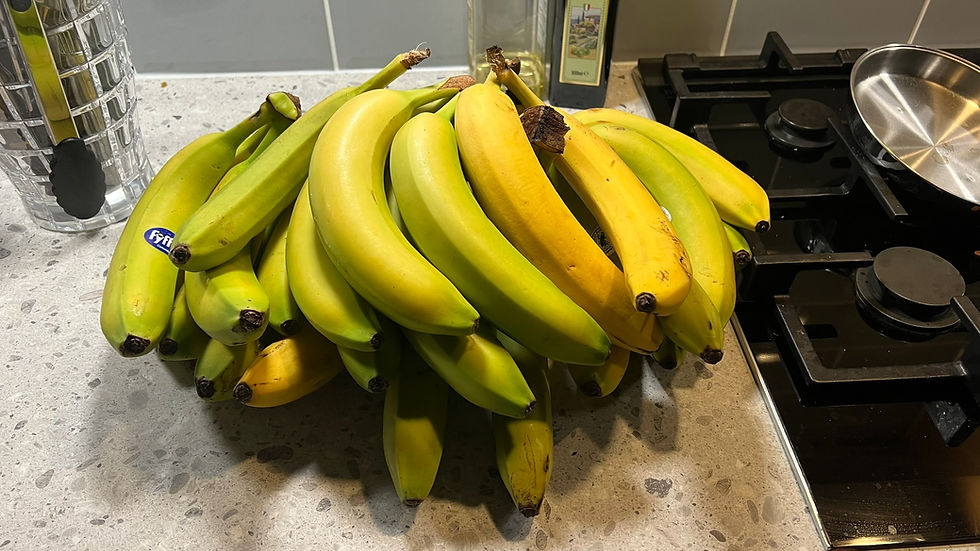
Bananas: My absolute staple, and I’m practically a banana evangelist! They’re easy on the stomach, loaded with carbs, and rich in electrolytes. I ate around 13 this race (though I’d packed 20, just in case).
Dates Stuffed with Marzipan: A festive favourite turned ultra fuel. Use Medjool dates for a caramel-like sweetness—perfect for a quick energy boost, plus some protein from the almonds.
Jam Sandwiches: Not just any jam, but my friend Susan’s mum’s homemade strawberry jam. High sugar, tasty, and comforting, they’re a go-to for easy calories.
Fruit & Nut Mix: I’ve relied on this since my first marathon. Nuts offer protein, fats, and salt; dried fruit provides extra carbs. Endurance events often demand a balance of all macros, not just carbs.
Tailwind: Ultra-processed, yes, but a lifesaver when you can’t handle solid food. The liquid calories help keep my intake consistent, especially overnight.
Maple Syrup ‘Gel’: My DIY energy pouch: maple syrup, salt, and lemon juice in a reusable baby-food bag. Perfect for quick, palatable sugar hits.
Towards the end, I battled a dry mouth, making solid foods tough to swallow. I plan on experimenting with homemade “baby food” blends next time to combat this.
Recovery & What’s Next
The first week post-race has been all about gentle walks with Michael and our dogs, allowing my mind and body to recover. I deliberately kept my calendar clear to avoid the temptation of another immediate event, giving myself time to savour the achievement and rest fully.

In the future, I’m hoping for a spot in the West Highland Way Race again and have also signed up for the Race Across Scotland—a 215-mile epic journey from west to east. It’s a race I once thought was years away for me, but the excitement tells me I’m ready. As for another backyard? I’m already signed up for Golspie 2025—how could I resist? Whether I also tackle Suffolk Backyard Ultra remains to be seen. I know I have many more yards in me, but I’m in no rush. For now, I’m savouring this victory and all it’s taught me.
Key Takeaways for Your Ultra Journey
Plan & Practise Fuelling: Avoid the mistakes I made at Rasselbock by testing different foods and drinks in advance, especially for overnight running.
Strategic Rest Pays Dividends: Even a few minutes off your feet or a brief micro-nap can make a massive difference over 24+ hours.
Adapt Your Training to You: Not every plan suits everyone. Experiment, reflect, and use what works best for your body and mind.
Positive Mindset is Powerful: Don’t suppress negative thoughts—acknowledge them, then refocus on the next checkpoint or reward.
Crew Support is Crucial: Look after your crew so they can look after you. Clear communication and downtime for them can make or break your experience.
Keep an Open Mind: You might achieve more than you think you’re capable of. And when it clicks, it can change your entire perception of what’s possible.
Thank you for joining me in reliving this extraordinary journey at the Golspie Backyard Ultra. Whether you’re a seasoned ultrarunner or just starting out, I hope my experience offers insights, inspiration, and maybe a spark of courage to push your own boundaries. Remember: each hour brings a new start line, and there’s no telling how far you can go until you try.
If you have any questions or want to share your own race experiences, feel free to drop a comment. I love hearing from fellow runners and supporting you on your own journeys. Happy running—and maybe I’ll see you at a future backyard start line!
Ready to go beyond your limits?
If you're training for your first ultra—or aiming to go further than ever before—I offer personalised, mindset-focused coaching that challenges the norm and gets results.
Book a FREE call with me and lets talk all things running! No sales pitch, no obligation!
👉 Apply for coaching. Limited spaces. Powerful results.



Comments